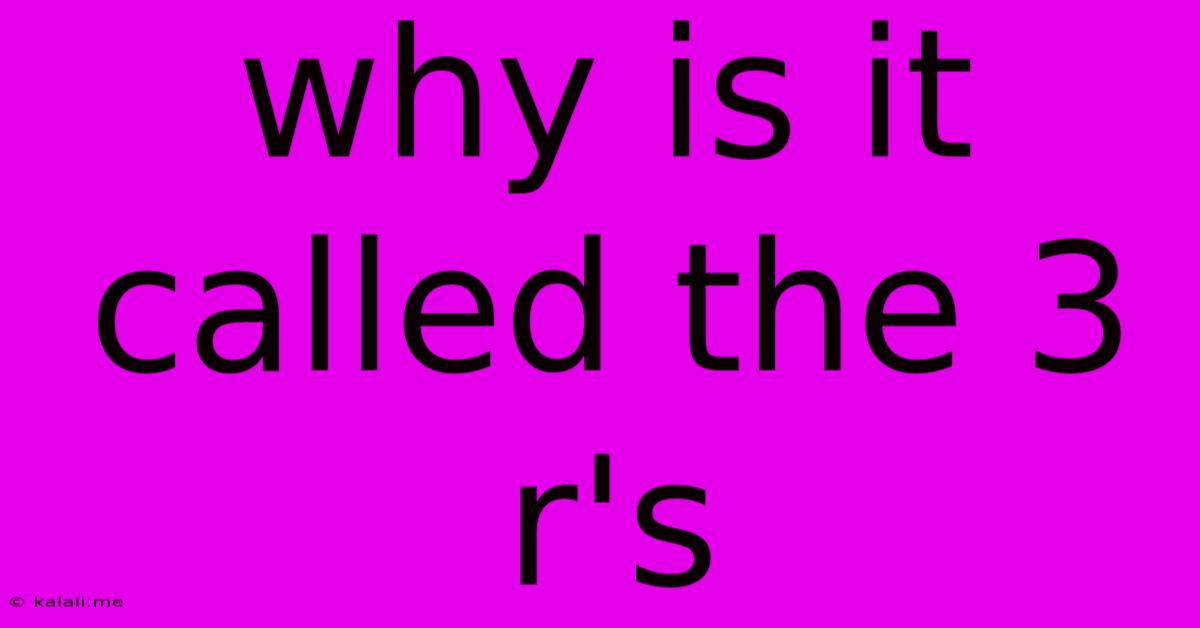Why Is It Called The 3 R's
Kalali
Jun 03, 2025 · 3 min read

Table of Contents
Why Is It Called the 3 R's? Understanding Reduce, Reuse, Recycle
The ubiquitous "3 R's" – Reduce, Reuse, Recycle – are a cornerstone of modern waste management and environmental consciousness. But why are they called the 3 R's, and what's the significance of their order? This article delves into the history and meaning behind this simple yet powerful environmental mantra, exploring its evolution and impact on sustainable practices.
The 3 R's represent a hierarchy of waste management strategies, prioritizing prevention over disposal. This hierarchy reflects the decreasing environmental impact of each action. Let's break down each "R" and understand its place in this crucial framework:
Reduce: The Foundation of Sustainable Consumption
Reduce focuses on minimizing waste generation at its source. This means consuming less, buying only what's needed, avoiding excessive packaging, and opting for products with minimal waste. This is the most environmentally beneficial step because it prevents waste from ever being created. Think about it: less consumption translates to fewer resources extracted, less energy used in manufacturing, and fewer emissions released into the atmosphere. Examples of reducing include:
- Buying in bulk: Reduces packaging waste.
- Choosing reusable items: Instead of single-use plastics.
- Repairing instead of replacing: Extending the lifespan of products.
- Digitalization: Reducing paper consumption.
- Mindful shopping: Buying only what you truly need.
Reuse: Extending Product Lifecycles
Reuse emphasizes finding alternative uses for items before they become waste. This involves repurposing, repairing, and donating items rather than discarding them. Reusing items significantly reduces the demand for new products and conserves resources. Consider these examples:
- Repurposing glass jars: For storage or organization.
- Donating clothes: Giving them a second life instead of throwing them away.
- Using reusable shopping bags: Instead of plastic bags.
- Repairing broken items: Instead of immediately buying replacements.
- Upcycling materials: Transforming old items into something new and valuable.
Recycle: The Last Resort
Recycle involves processing used materials to create new products. While a crucial part of waste management, it's the least environmentally preferable option compared to reducing and reusing. Recycling requires energy and resources, and not all materials are easily recyclable. Effective recycling programs are essential for the success of this R. Remember to:
- Check your local recycling guidelines: Different areas have different rules.
- Clean and properly sort your recyclables: This ensures efficient processing.
- Support businesses that use recycled materials: This encourages a circular economy.
- Understand which materials are actually recyclable: Not everything labeled "recyclable" can actually be recycled effectively.
- Advocate for better recycling infrastructure: A well-functioning system is key.
The Order Matters: A Hierarchy of Sustainability
The order of the 3 R's – Reduce, Reuse, Recycle – is deliberate and reflects their relative environmental impact. Reducing waste at its source is always the most effective strategy. Reuse offers a second chance for products before recycling becomes necessary. Recycling is the last resort, a vital but resource-intensive process that should be considered after all other options have been exhausted. Remember, prioritizing Reduce and Reuse significantly reduces the burden on recycling systems and minimizes environmental impact. The term "3 R's" itself is a shorthand, a simple and memorable way to communicate this crucial environmental hierarchy. The simplicity of this mnemonic device contributes significantly to its widespread adoption and effectiveness in promoting sustainable practices.
Latest Posts
Latest Posts
-
Alternatives For Book Of Shadows 5e
Jun 04, 2025
-
Dnd Can Faceless Be Someone Hiding Their Race
Jun 04, 2025
-
Best Books On Modern Monetary Theory
Jun 04, 2025
-
Can You Put A Block Heater On A Gas Engine
Jun 04, 2025
-
Three Houses Are Saint Statues Just For Byleth
Jun 04, 2025
Related Post
Thank you for visiting our website which covers about Why Is It Called The 3 R's . We hope the information provided has been useful to you. Feel free to contact us if you have any questions or need further assistance. See you next time and don't miss to bookmark.